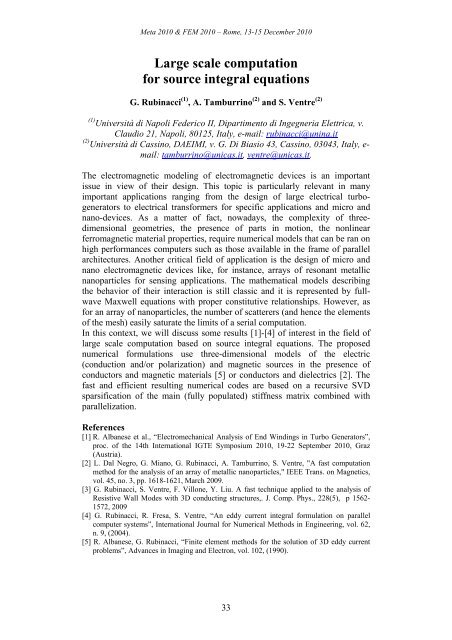Abstracts - Dipartimento di Elettronica Applicata
Abstracts - Dipartimento di Elettronica Applicata
Abstracts - Dipartimento di Elettronica Applicata
Create successful ePaper yourself
Turn your PDF publications into a flip-book with our unique Google optimized e-Paper software.
Meta 2010 & FEM 2010 – Rome, 13-15 December 2010<br />
Large scale computation<br />
for source integral equations<br />
G. Rubinacci (1) , A. Tamburrino (2) and S. Ventre (2)<br />
(1) Università <strong>di</strong> Napoli Federico II, <strong>Dipartimento</strong> <strong>di</strong> Ingegneria Elettrica, v.<br />
Clau<strong>di</strong>o 21, Napoli, 80125, Italy, e-mail: rubinacci@unina.it<br />
(2) Università <strong>di</strong> Cassino, DAEIMI, v. G. Di Biasio 43, Cassino, 03043, Italy, email:<br />
tamburrino@unicas.it, ventre@unicas.it.<br />
The electromagnetic modeling of electromagnetic devices is an important<br />
issue in view of their design. This topic is particularly relevant in many<br />
important applications ranging from the design of large electrical turbogenerators<br />
to electrical transformers for specific applications and micro and<br />
nano-devices. As a matter of fact, nowadays, the complexity of three<strong>di</strong>mensional<br />
geometries, the presence of parts in motion, the nonlinear<br />
ferromagnetic material properties, require numerical models that can be ran on<br />
high performances computers such as those available in the frame of parallel<br />
architectures. Another critical field of application is the design of micro and<br />
nano electromagnetic devices like, for instance, arrays of resonant metallic<br />
nanoparticles for sensing applications. The mathematical models describing<br />
the behavior of their interaction is still classic and it is represented by fullwave<br />
Maxwell equations with proper constitutive relationships. However, as<br />
for an array of nanoparticles, the number of scatterers (and hence the elements<br />
of the mesh) easily saturate the limits of a serial computation.<br />
In this context, we will <strong>di</strong>scuss some results [1]-[4] of interest in the field of<br />
large scale computation based on source integral equations. The proposed<br />
numerical formulations use three-<strong>di</strong>mensional models of the electric<br />
(conduction and/or polarization) and magnetic sources in the presence of<br />
conductors and magnetic materials [5] or conductors and <strong>di</strong>electrics [2]. The<br />
fast and efficient resulting numerical codes are based on a recursive SVD<br />
sparsification of the main (fully populated) stiffness matrix combined with<br />
parallelization.<br />
References<br />
[1] R. Albanese et al., “Electromechanical Analysis of End Win<strong>di</strong>ngs in Turbo Generators”,<br />
proc. of the 14th International IGTE Symposium 2010, 19-22 September 2010, Graz<br />
(Austria).<br />
[2] L. Dal Negro, G. Miano, G. Rubinacci, A. Tamburrino, S. Ventre, "A fast computation<br />
method for the analysis of an array of metallic nanoparticles," IEEE Trans. on Magnetics,<br />
vol. 45, no. 3, pp. 1618-1621, March 2009.<br />
[3] G. Rubinacci, S. Ventre, F. Villone, Y. Liu. A fast technique applied to the analysis of<br />
Resistive Wall Modes with 3D conducting structures,. J. Comp. Phys., 228(5), p 1562-<br />
1572, 2009<br />
[4] G. Rubinacci, R. Fresa, S. Ventre, “An eddy current integral formulation on parallel<br />
computer systems”, International Journal for Numerical Methods in Engineering, vol. 62,<br />
n. 9, (2004).<br />
[5] R. Albanese, G. Rubinacci, “Finite element methods for the solution of 3D eddy current<br />
problems”, Advances in Imaging and Electron, vol. 102, (1990).<br />
33








